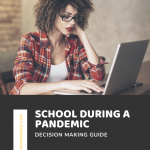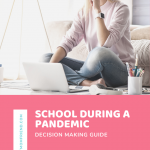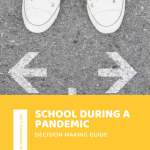
This post may contain affiliate links, which means I may receive a commission, at no extra cost to you, if you make a purchase through a link. Please see my full disclosure for further information.
First I need to say, there is no right decision to be made about returning children to school. There is only the right decision for your family. If you haven’t read School In A Pandemic: Send Them or Keep Them Home, please do so. It is important to understand that this is your decision to make.
We are in a time where the world feels upside down and many of us are struggling with the loss of things that brought us comfort, coping skills that have been rendered unavailable, and disconnect from our networks that usually help to keep us well. On top of it, we are experiencing information overload, and unfortunately, that information flows from multiple directions and changes constantly. It can be paralyzing, and now we need to make a massive decision. Do we send our kids to school or keep them home?
For many of us, it is really hard to know where to start with that decision, so I encourage you to use the guide below to help get you started on your path to deciding for your family.
At the bottom of this guide, you’ll find access to my decision-making worksheet!

A good rule of thumb, we can reduce stress through preparation and a plan.
Decision Making Process
The Question: Do I Return My Children to School or Not?
This may look slightly different for some of you, but for the sake of guidance, we will start with a place of sending our kids to school, or not.
Identify Your “Non-Negotiables”
Non-negotiables act as your bottom lines, they are the things that all decisions must protect. Examples may look like the following:
My child/family needs to be physically safe
My child needs to have contact with other children
My child needs to be emotionally well
My child needs to receive a school delivered education
I am unable to stay home with my children (ie I am required at work)
*It is likely that your non-negotiables will stem from your biggest worry or your child/family’s most significant vulnerability
Identify Your Priorities
Priorities could be those things that you recognize as important and that you would like to see in place, but may not be non-negotiables. For example, your non-negotiable may be that they be physically safe, but social interaction remains a priority as it significantly impacts your child’s emotional well-being.
Your priorities center around your family and child’s biggest needs.

Collect Your Information
It is difficult to make decisions without information. It is often a positive thing for us to avoid daily emotion-inducing headlines that pop up on social media or to sell newspapers, however, we must seek actual information to make our decisions.
Gather information crucial to your decision making from trusted resources. If you’re not sure where to turn for reliable information, check out Johns Hopkins’s guide to Finding Reliable Health Information Online. You may wish to seek answers to the following questions:
What is does community spread look like in my area?
How does my local public health department address this?
Is there contact tracing in place? How will they respond if someone is sick?
What is the most recent information about transmissibility?
Does my child or anyone in our house have health issues that make them high risk?
What is my school boards plan to address the following (cleaning, sick teachers, extracurriculars, supply teachers, physical contact, mental health support, etc.)
How does my child feel?
What else do I need to know?
What Options Are Being Presented?
This looks very different depending on your country, province/state, county, the board of education, etc. Most commonly, schools seem to be offering three plans; a full-time return to the classroom, a full-time online curriculum, or a hybrid model that reduces the number of children in school and combines part-time in-person learning and part-time online learning.
Identify Alternative Options
What are your options outside of those being offered to you by the school, or alongside them? This is where you may need to dig deep and get creative – especially if you are unsure about returning them.
Some examples of this may be that you could explore homeschooling or unschooling. You could utilize a tutor to homeschool your children. You could bubble with one or two other families and homeschool your children together, putting one parent in charge of education, or alternating, thus creating a support network and a social network, etc.

Consider The Chain Reaction
No matter what decision you make, it will impact other aspects of your life, solve other issues, or create new problems. When exploring your options, those presented by the school, and alternatives you are considering, what would be the consequences? Intended or otherwise.
Things to consider:
Does this impact your work? How does it impact your mental health? Your social well-being? Your Child’s mental health? Their social well-being? Will it create any inequities for your child? Will it allow new opportunities for your child or your family? How will it impact your relationships (friends, family, school)?
Example 1
If my children return to school the risk is higher for our family, and we will no longer be able to visit with grandparents or other important people in our lives. A return to school means increased social time with friends and less family time and possibly missed holidays with extended family. My child’s emotional well-being will be better because of their social time, but my mental health will suffer from decreased contact with my support system. I will have more time to myself during the day, however, my stress will increase from worry about COVID, and lacking some of my support systems, I worry that I will not be parenting as well as I otherwise could.
Example 2
If I keep my child home we will have minimal risk and my stress/worry/anxiety will be reduced. I will parent better. We will have the support of extended family as we will not pose a risk when visiting them. However, my child will miss their friends and not be emotionally as well. If their friends all return to school, they will move on without them, ultimately my child could be left behind or out of those friendships in the future. My child is aware of this and will worry, adding further stress to their emotional well-being. While I will not be stressed about the virus, I will be stressed and worried about my child’s emotional and social well-being.

Consider Each Option Individually
With the information in hand and having a thorough understanding of your options, it’s time to look more closely at them.
Questions we will ask:
Does this option meet my non-negotiables?
Does it meet my priorities?
What other problems does this option solve?
What other problems does this option create?
Are there things I can do to solve those secondary problems?
Will our risk for illness be high, moderate, or low?
Will our happiness be high, moderate, or low?
Will education opportunity be high, moderate, or low?
On a scale of 0 to 10, with 0 being Very Uncomfortable and 10 being Very Comfortable, what number would I be if I were to scale my feelings? Is there anything I could do to adjust this option to make my number higher?
If there is Information Missing, Find It
Often going through this process will help you to see gaps in information or further questions. Find the information you need to fill these gaps in the best you can.
Compare Your Options and Choose A Plan
Now that you have thought through your options, is there a clear decision for you and your family? If there isn’t a clear decision, which option is the best? Can that option be adjusted in any way that would increase your comfort with it? Can you combine any of your options to work together? Are there any other creative options that can better meet your needs? When is your decision deadline?
Remember, the world is not ok right now, and there is a good chance you will not feel 100% at ease with any option. Unfortunately, not deciding is a decision. The goal here is to have a strong understanding of your options so that you can make an educated decision and find the route that you will be the most comfortable.

Now that you have made the decision, you can breathe a sigh of relief and let go of some stress…but the “thinking” isn’t done. (It never is with parenting, is it!?)
Take Action On Your Decision
What steps need to happen now that you have made your decision? How do you prepare to implement it? What needs to be put into place?
Continuously Assessing
The current pandemic situation is fluid. One thing we have learned is that there will be constant new information and regular changes. The decision you make to start the year may not be what works for your family midway through the year. Take a few minutes and consider how you will assess the fit of your decision later on.
Will you revisit the scaling (0-10) question and adjust things as needed? Will you be able to tell based on your family’s happiness level on a day to day basis? Will you be able to tell based on your levels of stress or worry? Will you be able to tell by your child’s academic success? Take some time and consider what your indicators will be later so that you can stay on top of your decision making.
How will you know your plan is successful?
You must be able to tell when your decision is successful so that you can let go of the worry and stress. Take a moment and consider what your life will look like if your decision is the right one and is still working for your family. This may look like:
I will know it is successful when I can say “little Johnny is so happy”
I will know it is successful when I can say “he is enjoying his learning”
I will know it is successful when I can say “our family is stress-free”
I will know it is successful when I can say “we are connected to our friends and family”
I will know it is successful when I can say “we are confident we have minimized our risk”
There are no rules here, this is strictly about your family’s happiness and knowing that you have mitigated the biggest worries that you had when you started your decision-making process.
How will you know your plan needs to change?
As important as it is for you to have markers for success with your decision making, it is important to have markers for when it is time to revisit your decision. When will you reassess? Examples of this may be as simple as when your markers of success are no longer present or may be based on external information such as when trends in your community spread change or a set time frame that you set. Before you put this decision behind you, take a moment to take note of when you would revisit your decision or what could happen that would cause you to re-evaluate.
There is no getting around this being a tough decision, but I know it’s one that you can make!
Use this guide to walk your way through my decision-making form and you’ll be on your way to stepping out of the overwhelm and into a decision.




